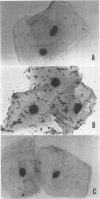Abstract
The possible relationship between the ability of Streptococcus species to adhere to oral epithelial cells and their natural distribution on epithelial surfaces within the mouth was studied. Strains of S. salivarius and S. sanguis, which are present in significant proportions on oral epithelial surfaces, were found to possess a definite capacity to adhere to epithelial cells obtained from cheek scrapings of humans, hamsters, and germ-free rats. In contrast, strains of S. mutans, which are found in only minor proportions, if at all, on oral epithelial surfaces exhibited feeble or no adherence to oral epithelial cells. S. salivarius cells attached well to human cheek cells over the range of pH 5 to 8. Its adherence was not found to be markedly influenced by saliva or by growth in sucrose broth. Several other types of bacteria were examined which also exhibited widely different abilities to attach to human cheek cells. Mixtures of streptomycin-labeled strains were introduced into the mouths of volunteers for study of the adherence of Streptococcus species to oral epithelial surfaces in vivo. Labeled S. salivarius and S. sanguis were recovered in high proportions from cheek and tongue surfaces, whereas the proportions of labeled S. mutans recovered from these surfaces were low in comparison to the original mixture. These data indicate that a correlation exists between the relative adherence of various Streptococcus species and their proportional distribution found naturally on oral epithelial surfaces. The ability of bacteria to adhere to surfaces is proposed as a critical ecological determinant affecting their colonization in environments with open surfaces exposed to bathing fluids.
Full text
PDF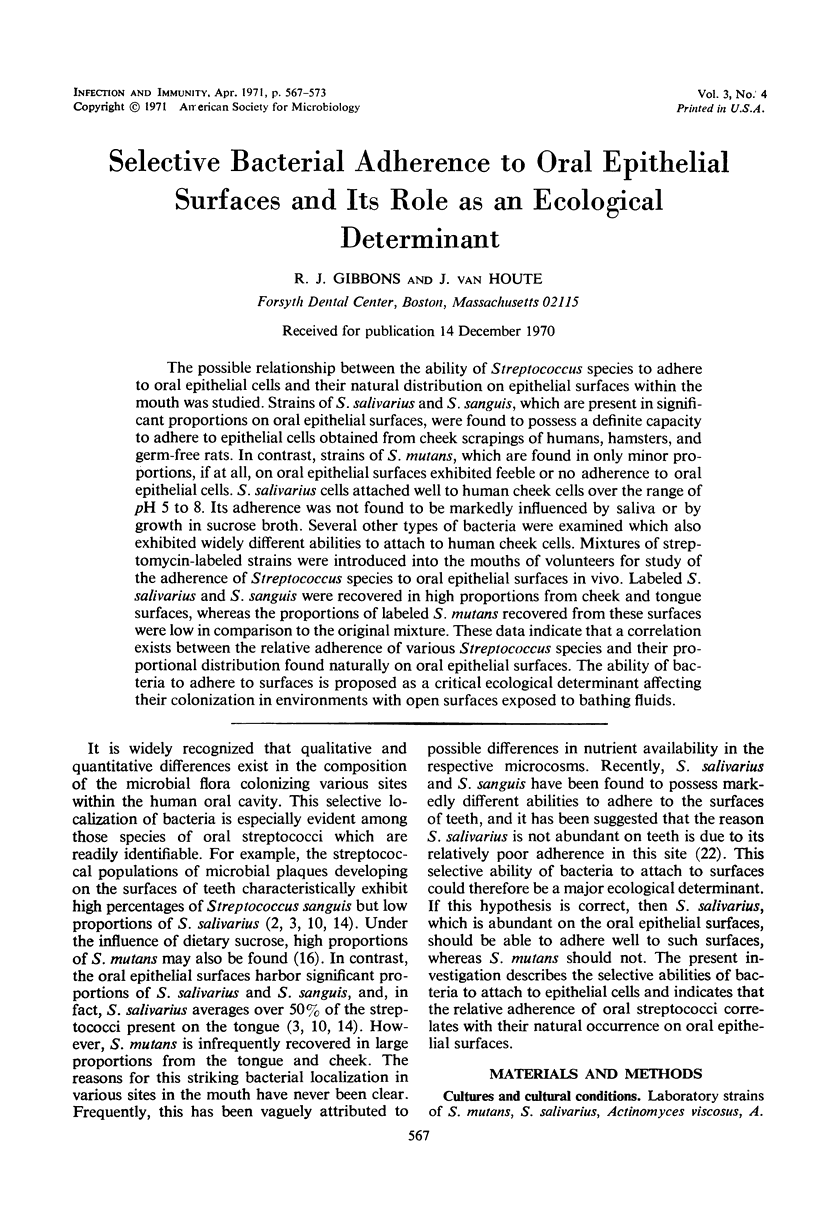
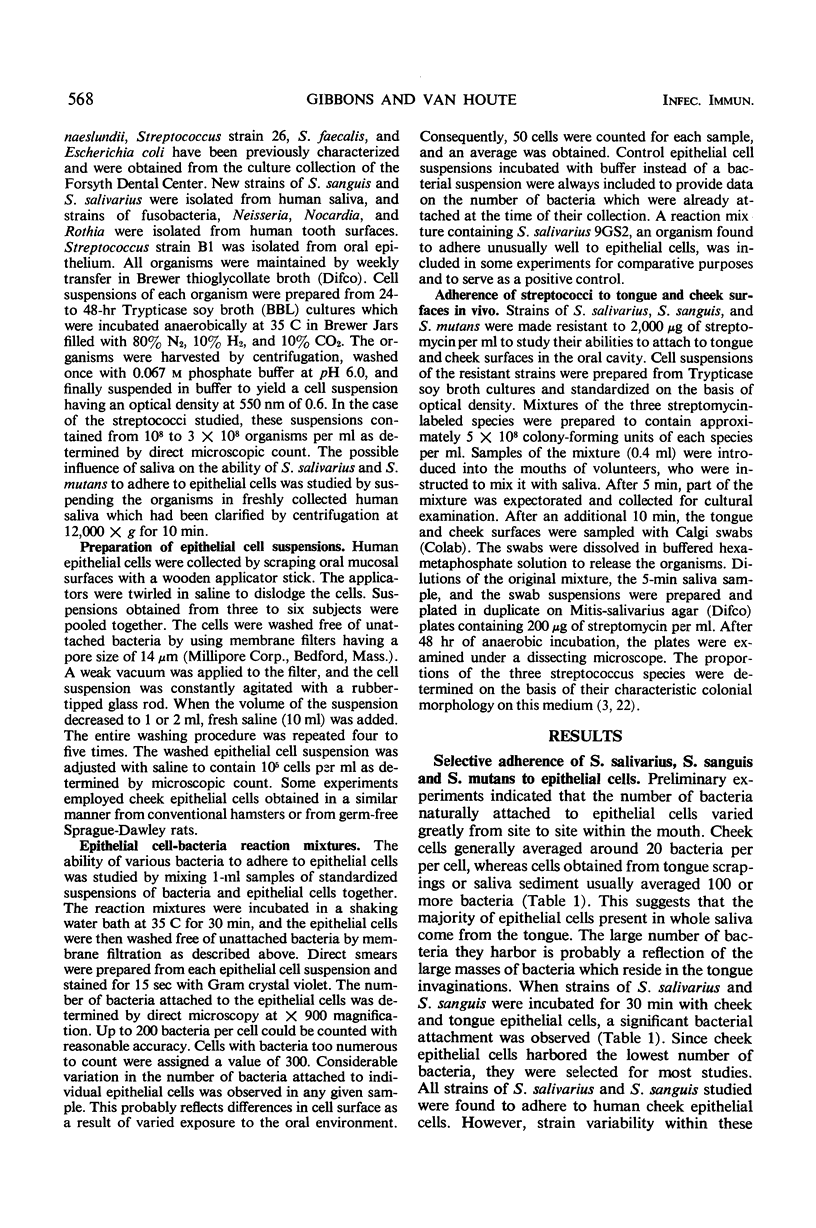

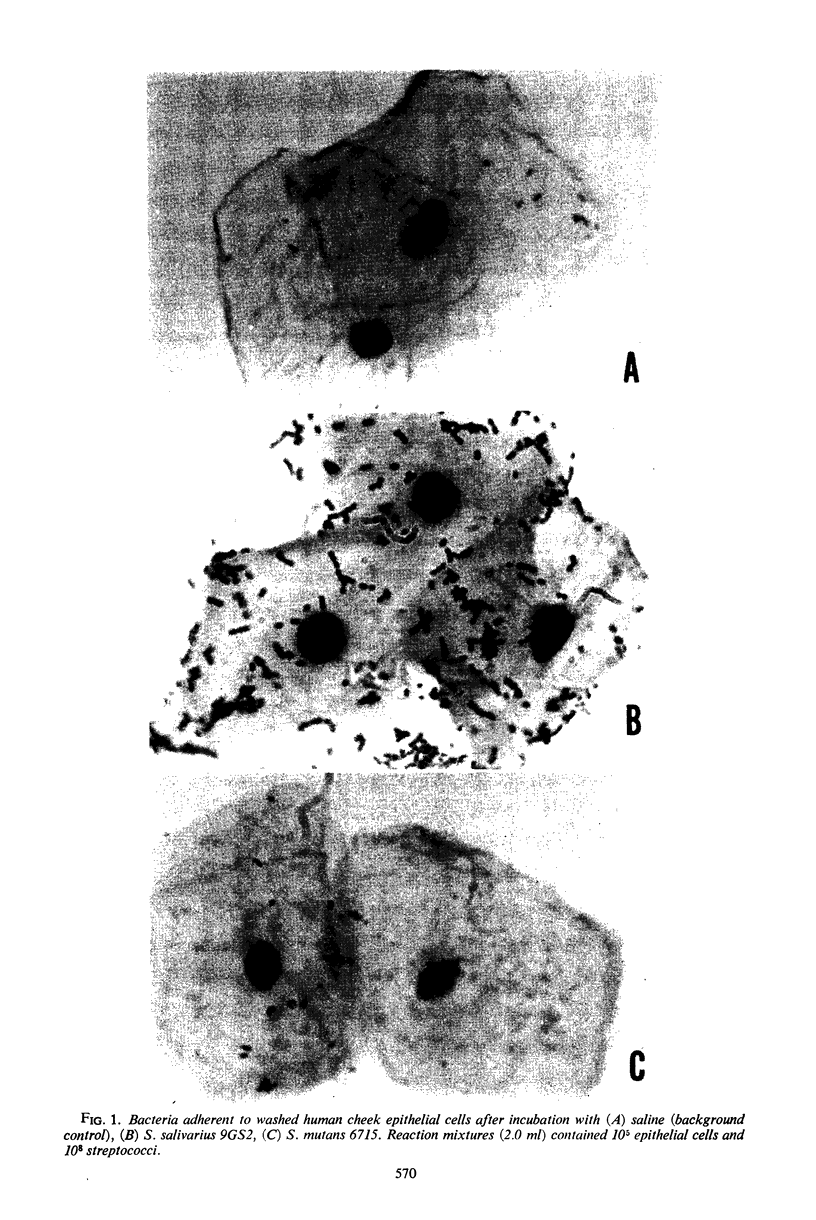

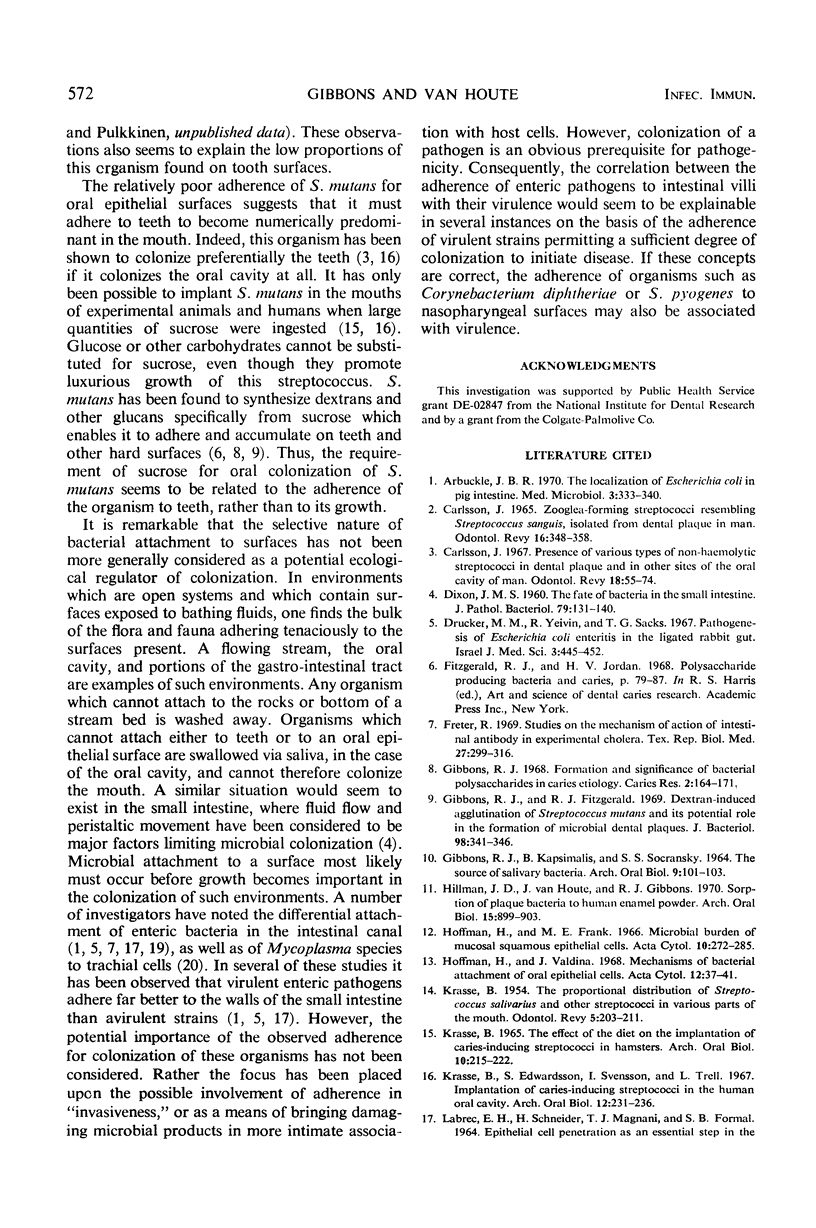
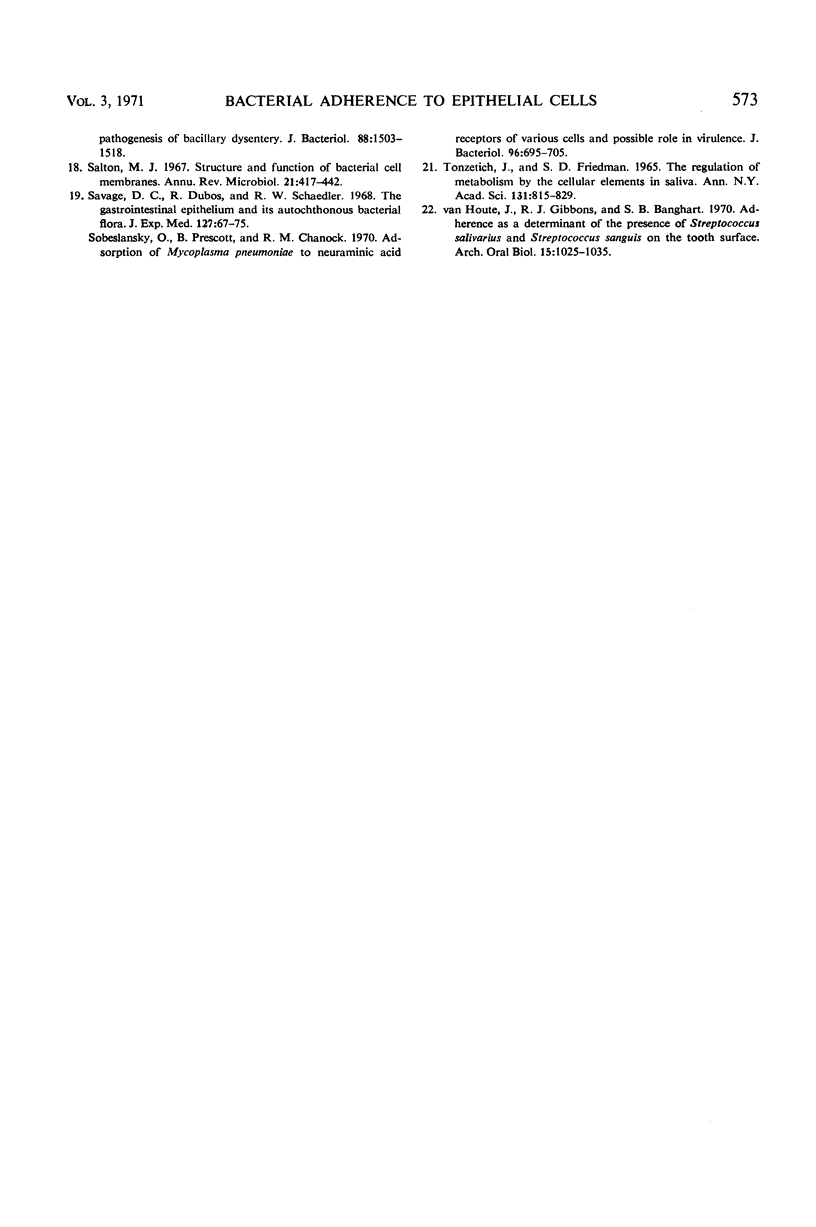
Images in this article
Selected References
These references are in PubMed. This may not be the complete list of references from this article.
- Arbuckle J. B. The location of Escherichia coli in the pig intestine. J Med Microbiol. 1970 May;3(2):333–340. doi: 10.1099/00222615-3-2-333. [DOI] [PubMed] [Google Scholar]
- Carlsson J. Presence of various types of non-haemolytic streptococci in dental plaque and in other sites of the oral cavity in man. Odontol Revy. 1967;18(1):55–74. [PubMed] [Google Scholar]
- Carlsson J. Zooglea-forming streptococci, resembling Streptococcus sanguis, isolated from dental plaque in man. Odontol Revy. 1965;16(4):348–358. [PubMed] [Google Scholar]
- DIXON J. M. The fate of bacteria in the small intestine. J Pathol Bacteriol. 1960 Jan;79:131–140. doi: 10.1002/path.1700790116. [DOI] [PubMed] [Google Scholar]
- Drucker M. M., Yeivin R., Sacks T. G. Pathogenesis of Escherichia coli enteritis in the ligated rabbit gut. Isr J Med Sci. 1967 May-Jun;3(3):445–452. [PubMed] [Google Scholar]
- GIBBONS R. J., KAPSIMALIS B., SOCRANSKY S. S. THE SOURCE OF SALIVARY BACTERIA. Arch Oral Biol. 1964 Jan-Feb;9:101–103. doi: 10.1016/0003-9969(64)90052-4. [DOI] [PubMed] [Google Scholar]
- Gibbons R. J., Fitzgerald R. J. Dextran-induced agglutination of Streptococcus mutans, and its potential role in the formation of microbial dental plaques. J Bacteriol. 1969 May;98(2):341–346. doi: 10.1128/jb.98.2.341-346.1969. [DOI] [PMC free article] [PubMed] [Google Scholar]
- Gibbons R. J. Formation and significance of bacterial polysaccharides in caries etiology. Caries Res. 1968;2(2):164–171. doi: 10.1159/000259554. [DOI] [PubMed] [Google Scholar]
- Hillman J. D., Van Houte J., Gibbons R. J. Sorption of bacteria to human enamel powder. Arch Oral Biol. 1970 Sep;15(9):899–903. doi: 10.1016/0003-9969(70)90163-9. [DOI] [PubMed] [Google Scholar]
- Hoffman H., Valdina J. Mechanism of bacterial attachment to oral epithelial cells. Acta Cytol. 1968 Jan-Feb;12(1):37–41. [PubMed] [Google Scholar]
- KRASSE B. THE EFFECT OF THE DIET ON THE IMPLANTATION OF CARIES-INDUCING STREPTOCOCCI IN HAMSTERS. Arch Oral Biol. 1965 Mar-Apr;10:215–221. doi: 10.1016/0003-9969(65)90022-1. [DOI] [PubMed] [Google Scholar]
- KRASSE B. The proportional distribution of Streptococcus salivarius and other streptococci in various parts of the mouth. Odontol Revy. 1954;5(3):203–211. [PubMed] [Google Scholar]
- Krasse B., Edwardsson S., Svensson I., Trell L. Implantation of caries-inducing streptococci in the human oral cavity. Arch Oral Biol. 1967 Feb;12(2):231–236. doi: 10.1016/0003-9969(67)90042-8. [DOI] [PubMed] [Google Scholar]
- Labrec E. H., Schneider H., Magnani T. J., Formal S. B. EPITHELIAL CELL PENETRATION AS AN ESSENTIAL STEP IN THE PATHOGENESIS OF BACILLARY DYSENTERY. J Bacteriol. 1964 Nov;88(5):1503–1518. doi: 10.1128/jb.88.5.1503-1518.1964. [DOI] [PMC free article] [PubMed] [Google Scholar]
- Salton M. R. Structure and function of bacterial cell membranes. Annu Rev Microbiol. 1967;21:417–442. doi: 10.1146/annurev.mi.21.100167.002221. [DOI] [PubMed] [Google Scholar]
- Savage D. C., Dubos R., Schaedler R. W. The gastrointestinal epithelium and its autochthonous bacterial flora. J Exp Med. 1968 Jan 1;127(1):67–76. doi: 10.1084/jem.127.1.67. [DOI] [PMC free article] [PubMed] [Google Scholar]
- Sobeslavsky O., Prescott B., Chanock R. M. Adsorption of Mycoplasma pneumoniae to neuraminic acid receptors of various cells and possible role in virulence. J Bacteriol. 1968 Sep;96(3):695–705. doi: 10.1128/jb.96.3.695-705.1968. [DOI] [PMC free article] [PubMed] [Google Scholar]
- Tonzetich J., Friedman S. D. The regulation of metabolism by the cellular elements in saliva. Ann N Y Acad Sci. 1965 Sep 30;131(2):815–829. doi: 10.1111/j.1749-6632.1965.tb34847.x. [DOI] [PubMed] [Google Scholar]
- Van Houte J., Gibbons R. J., Banghart S. B. Adherence as a determinant of the presence of Streptococcus salivarius and Streptococcus sanguis on the human tooth surface. Arch Oral Biol. 1970 Nov;15(11):1025–1034. doi: 10.1016/0003-9969(70)90115-9. [DOI] [PubMed] [Google Scholar]



